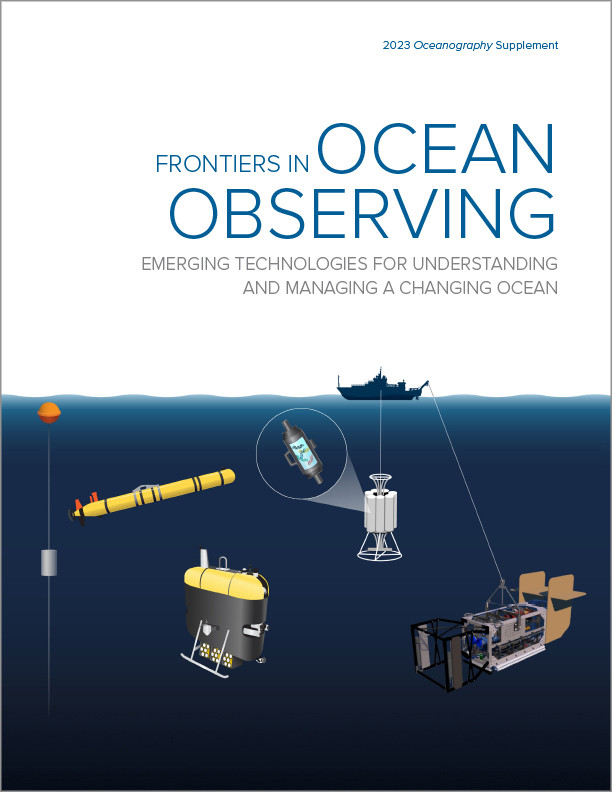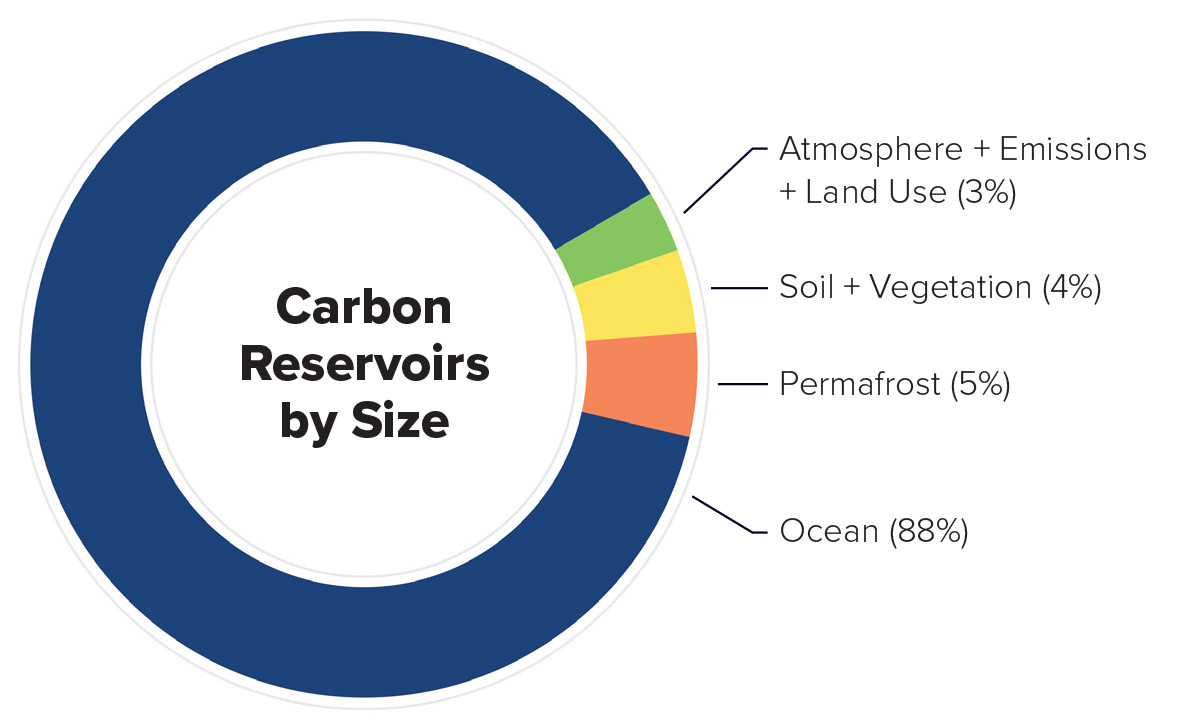Full Text
It has long been understood that stabilizing the global climate requires human carbon emissions to converge toward net zero (Matthews and Caldeira, 2008). Analysis by the Intergovernmental Panel on Climate Change (IPCC) suggests delays in achieving net zero emissions, or a temperature increase of more than 1.5°C, will necessitate even stronger action: net negative emissions. A very large-scale opportunity for carbon sequestration would include yet unproven ocean-based carbon dioxide removal (CDR) technologies (Rogelj et al., 2018).
The ocean is the largest carbon storage depot on Earth (Figure 1). It holds more carbon than the atmosphere and trees combined, thus, achieving net zero within the desired timeframe will not be possible without a better understanding of the ocean and its carbon-absorbing mechanisms. To that end, three actions
need to be taken:
- Create sustained and robust ocean observation systems, including data flows, reanalyses, and modeling that deliver reliable assessments of ocean carbon absorption.
- Align the multiple international conversations on ocean carbon in key intergovernmental organizations and in the research and observation communities.
- Engage nations in a comprehensive dialogue regarding support of ocean observation on the high seas, beyond national jurisdiction.
|
|
International Efforts
The IPCC has built a bedrock of climate information based on regular global assessments that rely on the careful compilation of scientific knowledge and an international consensus process to inform governments and other stakeholders of the climate trajectory. Internationally, UN agencies have consolidated the work of many nations to support and inform global action based
on IPCC analyses.
The World Meteorological Organization (WMO) recently launched a study group that aims for international consensus on a greenhouse gas monitoring system. The deep ocean remains largely outside the scope of these discussions, but the WMO has harnessed the work of the Global Ocean Observing System (GOOS), under the umbrella of the Intergovernmental Oceanographic Commission (IOC)/UNESCO, to fill this deficit. GOOS has proposed three major programs under the UN Decade of Ocean Science for Sustainable Development (2021–2030), including Ocean Observation Co-Design, which identifies ocean carbon observation as a key focus and seeks a first strategic carbon observing exemplar.
WMO, IPCC, and GOOS activities support the Global Climate Observing System (GCOS) Implementation Plan, which provided critical input to the United Nations Framework Convention on Climate Change (UNFCCC) when accepted by the Parties at COP27 in November 2022.
One of the most important developments in the intergovernmental climate conversation is the formation of a group of experts (GESAMP, undated) to frame ocean CDR technologies such as ocean fertilization and ocean alkalinity enhancement (NASEM, 2022) so researchers and observers can assess the challenges and risks.
However, many actors in these international discussions recognize the deficit in these systems: there are excellent global frameworks that create opportunities for climate action—but in general, do not drive or fund actions that would take advantage of these opportunities. This leaves many in the ocean community with fragile or declining observation systems, short-term funding, and increasingly stretched volunteerism within the ocean observation community (GOOS, 2022).
The Need for a Strategic Exemplar
A vision is needed for development of the world’s first international climate observatory that would record carbon and heat fluxes from the seafloor to the atmosphere. The observatory could emerge as a first move for a UNFCCC Global Goal for Observation, be nested in the GCOS Implementation Plan (as a Carbon Observatory under Action B6), become a mandated observation system under the WMO, or form a carbon exemplar for the GOOS Ocean Observation Co-Design program.
This initiative would require leading nations to communicate, pool, and coordinate their already substantial investments in observing infrastructure, and their expertise in the areas of science, policy, and innovation, to create information streams that would benefit all participants involved, along with the rest of the world.
Ocean Carbon
The ocean observation landscape is changing rapidly. More and more, the business community is signaling an eagerness (de Sanctis et al., 2022) to commercialize ocean CDR, and financial markets are indicating their willingness to build an active market in voluntary carbon credits. They realize both the climate urgency and the large economic opportunity at stake. Any such moves require transparency, intense scientific engagement, and a strong and credible framework for validation and certification. An international climate observatory would help to fill the gaps in ocean carbon data so that a baseline could be established for these purposes.
While the GCOS Implementation Plan calls for more traditional shipboard CTD casts and Argo floats (Buontempo et al., 2022), new technologies and exploding private sector interest mean major observations and insights are increasingly generated elsewhere (Brett et al., 2020). Frequently, ocean data flows originate from autonomous vehicles and private sector initiatives concentrated at the surface or in the upper 2,000 m of the ocean, rather than from research vessels that collect high-precision measurements that extend to the seafloor (Brett et al., 2020). A whole new level of siloed data management between private and public sectors hinders mapping and coordination of these data flows into actionable information. Breaking down communication barriers and encouraging data sharing across public and private sectors, and beyond national boundaries, is becoming an urgent task.
To be credible and effective, ocean CDR must be exceptionally well documented and carefully rolled out, and it must scale up quickly enough to impact the global climate. CDR verification requires synthesis of ocean data at multiple scales, from test tube to tank, from bay to continental shelf. Eventually, if ocean CDR is to reach gigatons of carbon removal and millennia of storage, it will have to include the open ocean. It is here, on the high seas, where global risks and carbon opportunities are greatest, that ocean observation and data integration is poorest.
Nations have the funding and resources to support robust ocean observing structures that reach beyond individual countries and outside exclusive economic zones to enable observations, scientific synthesis, and, potentially, safe sequestration of the biggest stores of carbon. It is important they come together to champion and bring to fruition the multiple intergovernmental initiatives under the UN Framework Convention for Climate Change, while maintaining a strong dialogue with the burgeoning private sector.
A new conversation is urgently needed to transform climate action.


